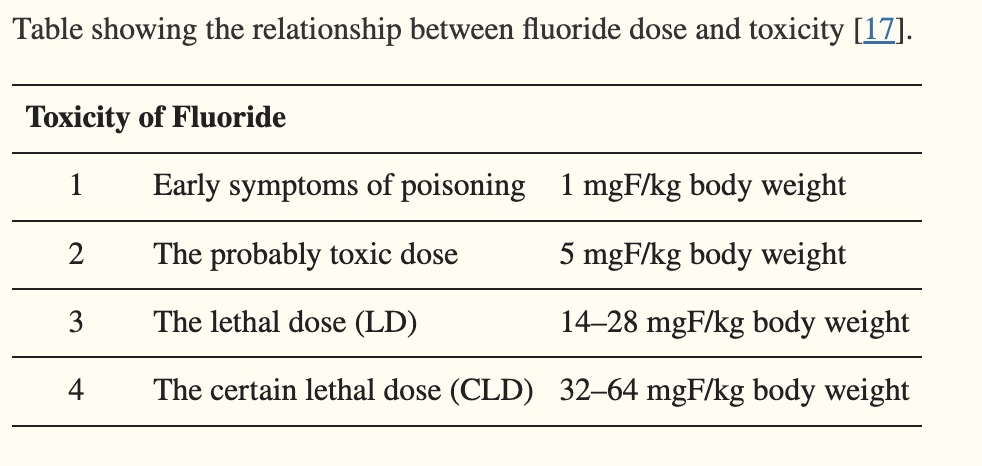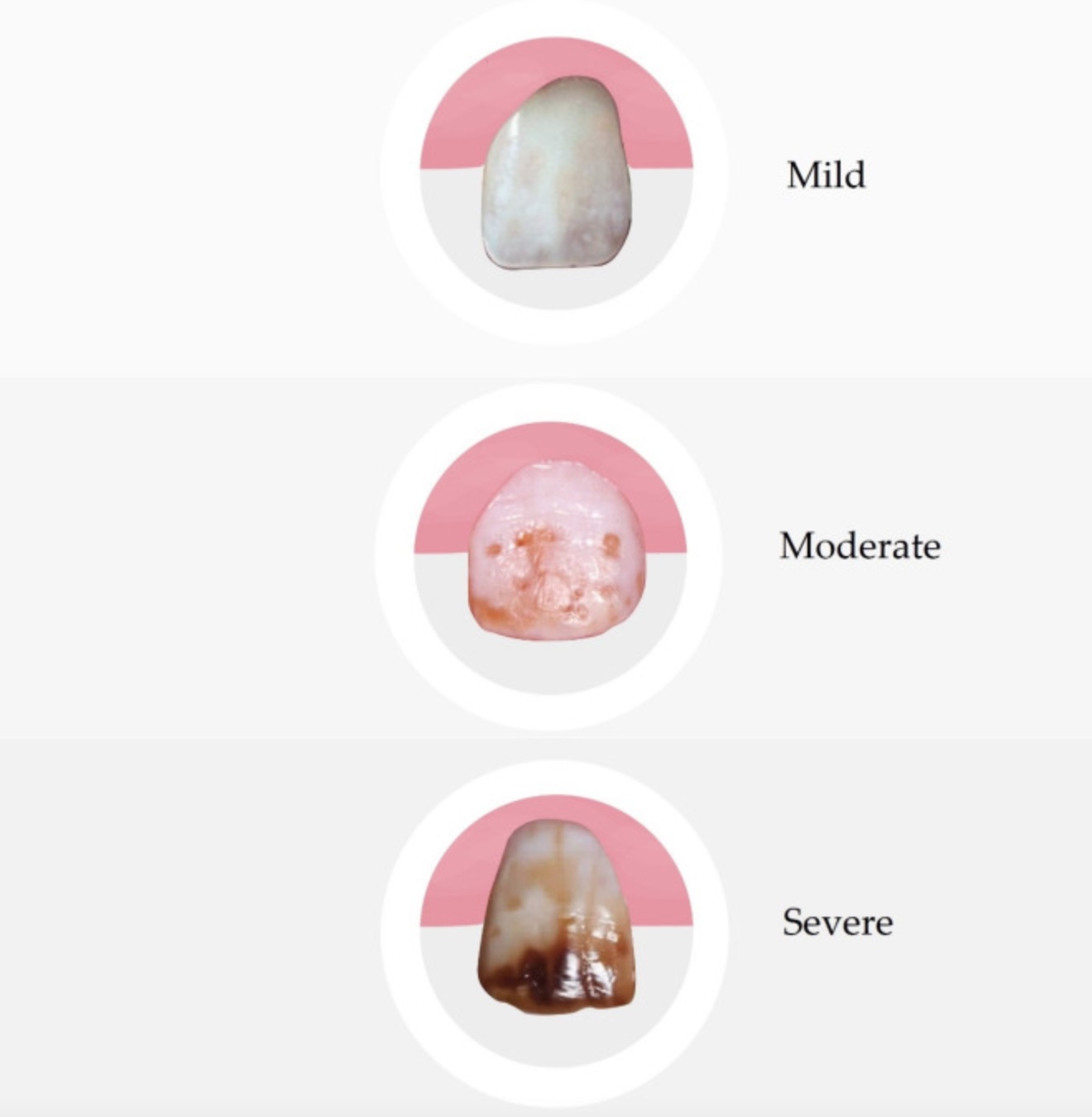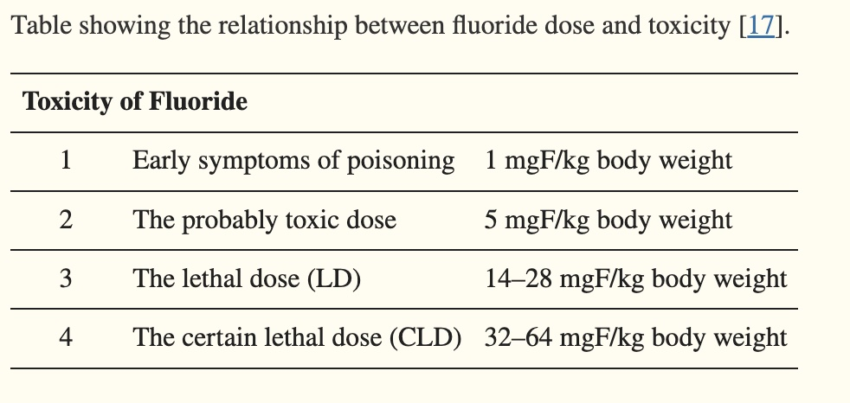Key takeaways:
~ Fluoride may help your teeth resist decay through increasing the resistance to acid produced by bacteria.
~ Too much fluoride is linked to skeletal and dental fluorosis, decreased IQ levels, and problems with thyroid hormone production.
~ Genetic variants impact your resilience to the negative effects of chronic fluoride consumption. Some people are more likely to be affected at lower levels, while others may not notice problems until fluoride exposure reaches higher levels.
~ There are many ways to reduce your exposure to systemic fluoride, if you want to concentrate the fluoride on your teeth.
Members will see their genotype report below, plus additional solutions in the Lifehacks section. Consider joining today.
Fluoride: Dental health vs. wellness
Is fluoride good for you or bad for you? Should you avoid it in your drinking water? Filter it from your shower? Or should you get as much as you can for your dental health?
Like many health questions, whether fluoride is ‘good’ or ‘bad’ is not simple to answer. Instead, you’ll need to understand how fluoride is absorbed in the bones and teeth, how much is needed, at what levels it is toxic, and how fluoride is eliminated from the body.
Some areas of the world have a lot more fluoride in the water than others, and diet (especially tea drinking) also plays a big role.
Additionally, genetics variants impact how well you detoxify fluoride.
Thus, the answer to the question – is fluoride good or bad – depends on a lot of different elements.
Let’s dive into the science so that you can make informed decisions for yourself.
What is fluoride? Where does it come from?
Fluorine (chemical symbol F) is an element commonly found in minerals in the Earth’s crust. It is strongly reactive, so elemental fluorine is rarely found in nature. Instead, fluorine is incorporated into minerals or other compounds.
Fluoride (F−) is an ionic form of fluorine, and the name can commonly refer to several compounds that contain fluoride. For example, sodium fluoride, an ingredient in many toothpastes, is often referred to simply as fluoride.
How Does Fluoride Stop Tooth Decay?
According to the CDC: “Fluoride works by stopping or even reversing the tooth decay process—it keeps tooth enamel strong and solid. Tooth decay is caused by certain bacteria in the mouth. When a person eats sugar and other refined carbohydrates, these bacteria produce acid that removes minerals from the surface of the tooth. Fluoride helps to remineralize tooth surfaces and prevents cavities from forming.” [ref]
No offense to the CDC, but that didn’t really explain how fluoride stops tooth decay. Let’s dig into it further…
Fluoride ions are taken up by bone tissue and other supporting tissue, including the teeth, skin, and hair.[ref]
In tooth enamel, fluoride can do an ion exchange with hydroxyapatite, which is a calcium containing compound that makes up part of your bones and tooth enamel.[ref]
Fluoride incorporates into the hydroxyapatite, forming fluoropatite, which is more resistant to the acidic pH caused by certain bacteria in the mouth. This facilitates the remineralization of enamel, preventing some cavities from forming when acidity is high.
Toxicity of Fluoride:
Fluoride is toxic in higher amounts. The saying “the dose makes the poison” definitely applies to fluoride. The question is: At what level is fluoride OK, and at what level does it cause harm.
While sources on this vary just a little bit, the symptoms of acute fluoride poisoning may appear with as little as 1mg/kg of body weight. Thus, for infants and small children, fluoride can be a problem at much lower levels than for adults.

According to Mt. Sinai hospital, symptoms of acute fluoride toxicity include:
- Abdominal pain, diarrhea, nausea and vomiting
- Abnormal taste in the mouth (salty or soapy taste), drooling
- Headache
- Irregular or slow heartbeat, heart attack (severe cases)
- Shallow breathing
- Tremors
Acute fluoride poisoning is fairly uncommon. One notorious case back in the 1940s was at the Oregon State Hospital. A patient at the mental hospital mistakenly brought cockroach poison, which was made of sodium fluoride, for the cooks to use in the kitchen instead of powdered milk. This caused acute fluoride poisoning in the Oregon State Hospital patients who ate the fluoride-laced food, with 47 resulting fatalities.[ref]
High fluoride in groundwater supplies:
Fluoride levels in the soil and water vary quite a bit. Most areas have natural fluoride levels in the water in the 10s to 100s of PPM (parts per million). However, in some areas of the world, fluorine concentrations in the water are high enough to cause health problems. This can be due to agricultural runoff (fertilizers), often combined with higher natural mineral levels in the water. [ref]
Average fluoride intake in the US:
Fluoride is now classified as a micronutrient and the US has determined an adequate intake of 3 mg/day for women and 4 mg/day for men. The upper daily limit is set at 10 mg/day.
Long term fluoride consumption:
Skeletal fluorosis is caused by long-term fluoride consumption at levels that are higher than tolerable. Skeletal fluorosis causes pain and damage to bones and joints due to the incorporation of fluoride into the bones and connective tissue.
The sources of fluoride people are commonly exposed to include drinking water (especially in certain areas of the world with high natural fluoride), fluoride inhalation from burning coal, and fluoride from drinking a lot of tea. The largest source is from tea consumption, especially in areas where the water also contains fluoride. [ref]
Researchers studied the causes of toxicity in fluorosis due to high fluoride water in a region in India. They found that there was a reduction in PON1, acetylcholine esterase, and ATPase. Both the heart and liver also showed altered lactate dehydrogenase. The researchers concluded that higher fluoride levels in the water had a collective effect on cellular energy production in fluorosis patients.[ref]
Dental fluorosis:
While a little bit of fluoride may help to strengthen enamel, too much fluoride can damage teeth. Excess fluoride, whether chronic or acute, can cause dental fluorosis, especially if it happens during the time that the permanent teeth are developing.
Enamel fluorosis initially causes whitish areas on the teeth. More severe enamel fluorosis causes pits and brown spots on the teeth.[ref]
Here’s what dental fluorosis can look like:

Intestinal Absorption and Excretion:
Fluoride is readily absorbed in the body. About 1% if absorbed in the mouth, with the rest absorbed in the stomach and small intestines. After absorption, the fluoride is transported throughout the body via the bloodstream. Concentrations in the blood stream peak 20-60 minutes after consumption.
Approximately 50% of absorbed fluoride is excreted – mainly through urine. Adults retain a little less fluoride, and children retain a little more fluoride.
About 99% of the remaining fluoride is concentrated in the calcified tissues (e.g. bones, teeth), with 1% entering the soft tissues (e.g. brain, lungs, kidneys). [ref]
Pregnant women pass about 60% of the concentration of fluoride in their bloodstream to the placenta at lower levels. At high concentrations, the placenta acts as more of a barrier to protect the fetus from high fluoride levels. Fluoride also passes through breast milk at low concentrations. [ref]
How did fluoride get added to drinking water?
In many towns and cities in the US and Canada, low levels of fluoride are added to municipal water supplies.
The history of using fluoride for preventing cavities dates back a century or more. It was observed that people with mottled stains on their tooth enamel (fluorosis) were exposed to high natural fluoride levels in their drinking water. An epidemiological study showed that people averaged fewer cavities in areas where dental fluorosis is more prevelant. In 1945, four US cities added 1mg/L of fluoride to their municipal water supplies, and they subsequently noted a decrease in cavities. This kicked off decades of research on fluoride for cavity prevention, including whether the fluoride was more effective if given topically on the teeth or systemically.[ref]
The CDC currently recommends 0.7 mg/L of fluoride in drinking water.[ref] Approximately 73% of municipal water systems in the US follow the CDC recommendations and have added fluoride to the water.[ref]
Vitamin D, fluoride, and bones:
I mentioned above that excess, chronic fluoride from drinking lots of tea or water high in fluoride can cause problems with bones.
Vitamin D is involved in how bones absorb minerals such as calcium – and fluoride. Genetic variants in the vitamin D receptor are linked to increased risk of skeletal fluorosis in people who are exposed to a lot of fluoride. (More in the genotype section)[ref]
Sodium fluoride was tried in the 80s and 90s as a way of preventing osteoporosis. However, long term studies showed that not only did fluoride not prevent osteoporosis, but it may actually make bone density slightly worse.[ref][ref]
Thyroid function:
Your thyroid needs iodine in order to synthesize thyroid hormones. Fluorine can impact how well the thyroid functions, and this is exacerbated when iodine intake is low.[ref]
TSH, thyroid stimulating hormone, is often measured to determine whether someone has hypothyroidism, or underactive thyroid gland activity. TSH levels above 4.5 mIU/L with normal thyroid (T3, T4) hormone levels usually indicates hypothyroidism. Some researchers consider TSH levels above 2.5 mIU/L as increasing the risk of subclinical hypothyroidism, which affects 5-10% of the population.[ref]
A recent study in Canada found that higher fluoride exposure is linked to thyroid dysfunction only in people who were also iodine deficient. With adequate iodine, no link between fluoride levels and higher TSH levels were seen. About 18% of the study participants were iodine deficient.[ref]
Sperm count and reproductive effects:
Animal studies show that high fluoride levels can impact sperm motility, and a study in the 1990s in India showed that higher fluoride exposure correlated with slightly decreased testosterone levels.
A recent study looked at men grouped by lower fluoride exposure (2-13mg/day) and higher fluoride exposure (up to 27mg/day). There was a decrease seen in sensitivity of FSH response to inhibin-B in the high fluoride group. However, none of the semen parameters were altered in the high fluoride group. The study concluded: “The results obtained indicate that a fluoride exposure of 3–27 mg/day induces a subclinical reproductive effect that can be explained by a fluoride-induced toxic effect in both Sertoli cells and gonadotrophs.”[ref]
Soft tissue calcification:
Fluoride can be incorporated into various tissues in the body, causing calcification. The question, in my mind, is whether this is relevant at levels that humans are chronically exposed to. Only about 1% of absorbed fluoride is stored in soft tissue.[ref]
In animal studies, higher chronic fluoride exposure increased calcification in the aorta (heart).[ref]
For people living in an area with high fluoride in the water, an x-ray study found that 89% showed “calcification and/or ossification of the attachments of ligaments, tendons, muscles, and interosseous membranes.”[ref]
Whether fluoride causes soft tissue calcification isn’t clear cut and likely has several variables involved. For example, in an animal study with a higher ratio of phosphorus to calcium than normal, the addition of fluoride reduced calcification in the kidneys.[ref]
Intelligence:
Higher levels of fluoride in the water is a problem for developing children, especially in countries with both agricultural runoff and naturally higher fluoride mineral levels. China is one country that has studied the effects of higher water fluoride levels fairly extensively.
Children who are exposed to higher fluoride in their water have slightly lower IQs, on average. This is a problem of serious concern in areas of China and India with higher groundwater fluoride concentrations.[ref]
Fluoride causes neurotoxicity in the brain by interfering with the activity of several metabolic enzymes. This can inhibit brain glucose utilization and affect mitochondrial function in the neurons. Additionally, animal studies clearly show that higher fluoride levels cause neurotoxicity.[ref]
A study of ~1,000 children in China divided the participants into two groups they called high intelligence (>120) and non-high intelligence (70-120). The average fluoride exposure of the high intelligence group was 0.7mg/l of water, while the non-high intelligence group had an average of 1mg/l of fluoride in their water.[ref] To be clear: the fluoride in the water for the ‘non-high intelligence’ group is above the range of what is added to fluoridated municipal supplies in the US and Canada.
Genetics plays a role in whether high fluoride in the water is more likely to cause decreased IQ levels. Genetic variants in the dopamine receptors and in enzymes related to dopamine breakdown are linked to decreased IQ with high fluoride exposure.[ref] (More in the genotype report)
Degenerative Eye Diseases:
Fluoride exposure also contributes to degenerative eye diseases, such as cataracts and macular degeneration.
A 2019 study foud that fluoride exposure is a risk factor for cataracts and macular degeneration, and it also elucidated the mechanism of action. The researchers found that fluoride impacts enzymes and genes related to mitochondrial energy as well as reactive oxygen species and oxidative stress (e.g. Nrf2, glutathione, NF-kB, heat shock proteins).[ref]
Fluoride Genotype Report
The total amount of fluoride someone is exposed to is important in understanding toxicity, but it isn’t the only variable that needs to be considered. Genetic variants in several genes also impact the different ways individuals respond to fluoride in regards to fluorosis, thyroid hormone production, and IQ.
Fluorosis related genes:
VDR Gene: Encoding the vitamin D receptor
Check your genetic data for rs2228570 (23andMe v4 only):
- A/A: typical; lower risk of skeletal fluorosis
- A/G: typical vitamin D levels[ref]; lower risk of skeletal fluorosis
- G/G: carrier of FokI variants, possibly decreased vitamin D levels, pos. increased risk of fractures[ref][ref][ref]; increased risk of tuberculosis[ref]; increased risk of skeletal fluorosis in people drinking tea with >7.0 mg F/day[ref]
Members: Your genotype for rs2228570 is —.
GSTP1 gene: encodes the glutathione S-transferase pi enzyme, which is a phase II detoxification enzyme
Check your genetic data for rs1695 (23andMe v4, v5; AncestryDNA):
- A/A: most common genotype
- A/G: somewhat reduced function, decreased risk of skeletal fluorosis with high fluoride consumption
- G/G: reduced function, decreased risk of skeletal fluorosis with high fluoride consumption[ref][ref]
Members: Your genotype for rs1695 is —.
SOD2 gene: Superoxide dismutase 2 is a manganese-dependent antioxidant enzyme responsible for breaking down toxins and eliminating reactive oxygen species in the cell.
Check your genetic data for rs5746136 (AncestryDNA):
- T/T: increased risk of dental fluorosis[ref]
- C/T: typical risk
- C/C: typical
Members: Your genotype for rs5746136 is —.
Check your genetic data for rs10370 (23andMe v4):
- T/T: increased risk of dental fluorosis[ref]
- C/T: typical risk
- C/C: typical
Members: Your genotype for rs10370 is —.
Thyroid related issues:
CREB1 gene: stimulates transcription of other genes including those in the thyroid
Check your genetic data for rs2253206 (23andMe v4, v5; AncestryDNA):
- G/G: lower total T4 (thyroid hormone) in children exposed to high fluoride levels[ref]
- A/G: typical
- A/A: typical
Members: Your genotype for rs2253206 is —.
Check your genetic data for rs6740584 (23andMe v5):
- C/C: lower total T4 (thyroid hormone) in children exposed to high fluoride levels[ref]
- C/T: lower total T4 in children exposed to high fluoride levels
- T/T: typical
Members: Your genotype for rs6740584 is —.
Intelligence:
DRD2 TaqI A (ANKK1 gene): polymorphism in the DRD2 gene that affects its function.[ref]
Check your genetic data for rs1800497 (23andMe v4, v5; AncestryDNA):
- A/A: (DRD2*A1/A1) reduced number of dopamine binding sites[ref] linked to lower IQ in children exposed to higher levels of fluoride in their water (study in China)[ref]
- A/G: (DRD2*A1/A2) typical response to fluoride in regards to IQ
- G/G: (DRD2*A2/A2) typical
Members: Your genotype for rs1800497 is —.
Lifehacks: Natural Ways to Decrease Fluoride Intake
You’ll need to weigh the pros and cons of fluoride for yourself, taking into consideration the benefits for cavity prevention as well as the long-term effects from higher fluoride exposure. The solutions below are geared towards reducing systemic fluoride exposure and facilitating detoxification.
The rest of this article is for Genetic Lifehacks members only. Consider joining today to see the rest of this article.
Member Content:
An active subscription is required to access this content.
Join Here for full access to this article, genotype reports, and much more!
Already a member? Log in below.
Related Articles and Topics:
Cavities and Your Genes:
Some people are much more susceptible to cavities due to genetics.

